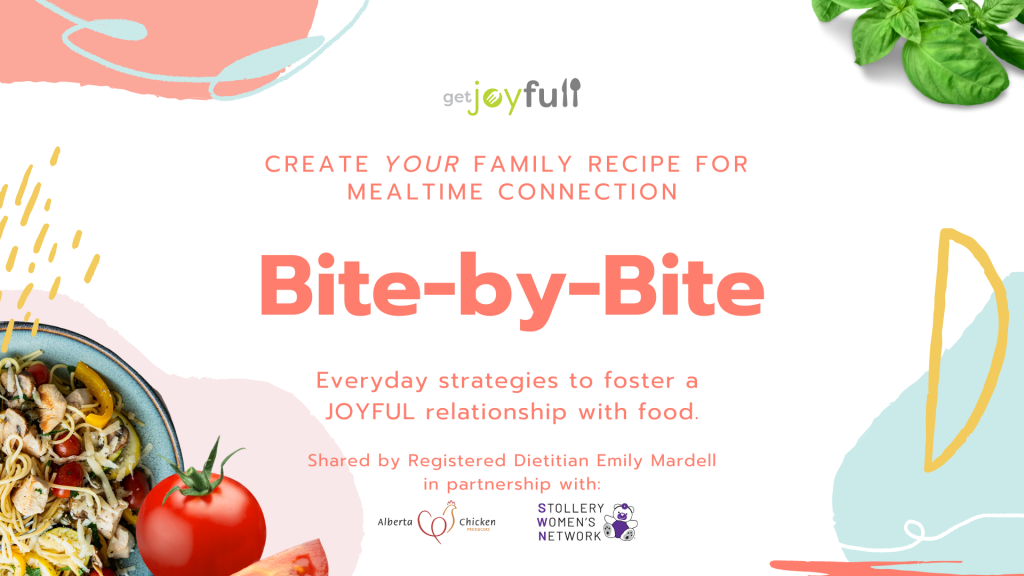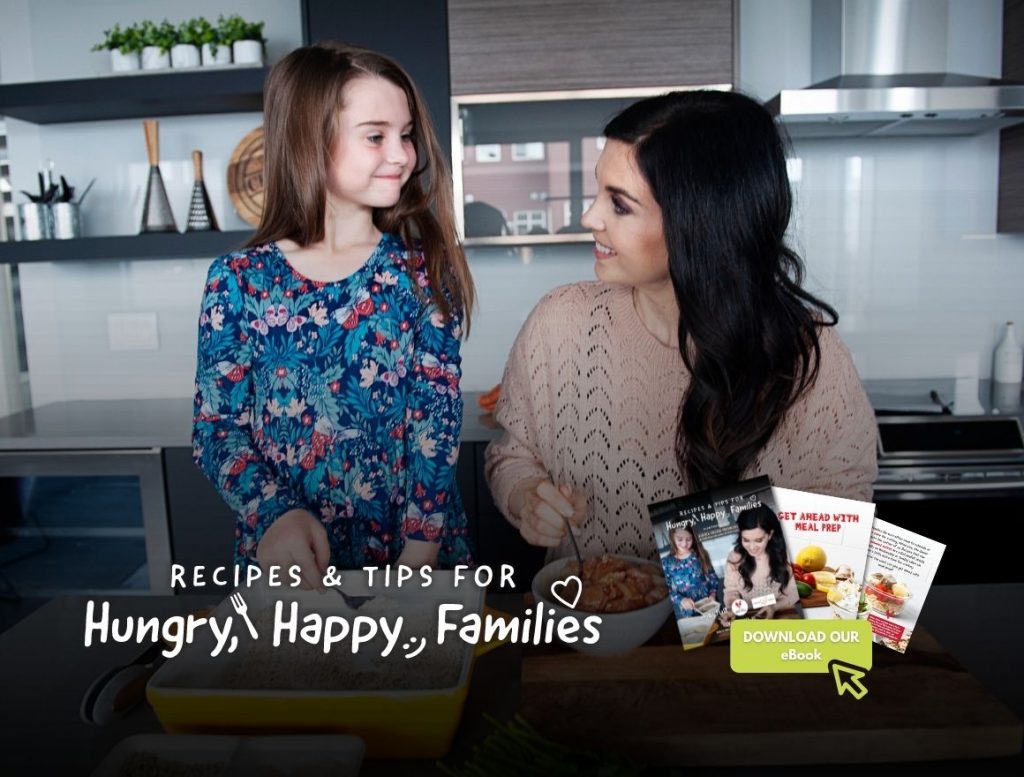I was recently invited by the Stollery Women’s Network and Alberta Chicken Producers to present at the October Stollery Spotlight virtual charity gathering. It was an honour and a joy! I can’t tell you how proud I am to be part of this Network, and to partner with organizations like Alberta Chicken Producers who are deeply committed to supporting healthy kids and families. For the Spotlight event, I decided on the theme of picky eating. I shared Dietitian tips to manage mealtime mayhem and foster a positive food relationship with food. The response was heartwarming, so I thought it was a good idea to capture the highlights!
If you have small children you have likely come up against mealtime struggles. They might spit out their food, “Yuck!, or just downright refuse to eat anything even recognizable as food. So if you have a child who will only eat bread and butter, a child who has never swallowed a vegetable, or a child who thinks dinner is a wrestling match, you are not alone.
In the GetJoyfull household, family mealtime might just be Sunday roast chicken & sides, or busy weeknight milk & cereal. Regardless, we’ve come to realize our “healthiest” meals always make room for a secret ingredient….CONNECTION.
Picky eating on some level is normal for all children. After all, almost everything “food” is somewhat new, or very new to kids. Especially when it comes to exploring food with all their senses. Learning to like a variety of foods takes patience, perseverance and perspective! Did I mention patience?
When it comes to feeding our children there is so much pressure on parents, especially primary caregivers, and as a Mama of little bear cubs who all eat differently, I have felt that pressure too. The truth is, there isn’t one single way of eating or feeding your children, and what works for one family might not work for the next. So let’s take the stress and anxiety out of it.
I’m passionate about finding solutions that allow children to learn and experience all the sensory wealth that comes from uncovering food joy! In fact – it is my life’s work!

That is why I was so thrilled to have been asked by the Stollery Women’s Network and the presenting sponsor Alberta Chicken Producers to speak on this topic. The Stollery is such a valuable resource to families in Edmonton. Alberta Chicken Producers and I partner up regularly to create farm-to-table recipes and to share nutrition tips about this go-to protein. In fact, we actually recently created an eBook, “Recipes & Tips for Hungry, Happy Families,” that’s filled with delicious meal ideas for family wellness and connection. You can download it here!
At the virtual Stollery Spotlight event, I was thrilled to share some of what I have learned as a Registered Dietician and as a mom to help cultivate food joy in children and take some of the stress out of mealtimes. Mealtime shouldn’t feel overwhelming or super stressful. It should be the time we connect and grow together as a family around food!
There are several versions of the picky eater and it may manifest itself in one of these eating behaviours.
- Complain about what has been offered and ask or demand something else.
- Not like foods because of their colour, taste or texture.
- Put food in their mouth, make a funny face and want to spit it out.
- Be unable to sit at mealtime
- Go on food jags of only liking a handful of foods
- Eat small portions and declare they are hungry when meal time is over.
- Refuse to eat anything at all
Remember it’s normal for kids not to like new foods. In fact what we often label as “picky” is simply normal developmental behaviour. As parents, it’s our job to offer a structured meal and snack routine, to strive to eat together as much as possible, and to role model healthy eating. Since the process may sometimes make us want to pull our hair out it can help to have reasonable expectations. It may take 15-30 times before your kid accepts a new food! Yikes.
I believe the foundation of a positive food relationship starts with HOW we are fed. Ellyn Satter, a renowned researcher, Dietitian and family therapist, is the health hero that definitely instilled this belief in me. Ellyn’s work has created so many helpful resources, books, and tools to help guide “feeding with love and good sense.” Her books and website ellynsatterinstitute.org are literally treasure troves for anyone who’s interested in learning more about feeding kids and the roots of the GetJoyfull movement and messaging.
“When the joy goes out of eating, nutrition suffers” – Ellyn Satter
At the heart of Ellyn’s work is the Division of Responsibility, which boils down to “The parent provides, and the child decides.” Ultimately, when feeding with love and good sense, parents are responsible for the WHAT, WHEN and WHERE of feeding, while children are responsible for IF, and HOW MUCH they eat.
This concept is simple, but in real life it takes practice and personalization. As the expert on your child, you will no doubt find little golden nuggets that help your kiddo grow and progress as a healthy eater. Hopefully some “food for thought” on common “picky eating” scenarios help, too!
If picky eating is an issue in your household you might recognize these top 3 types of eaters.
THE GRAZER
This is the kid who is hungry, or “peckish” all day long. He prefers to eat on-the-go or while playing or screen watching. It’s nearly impossible for him to sit still during a meal, and he raids the pantry on the regular! 15 minutes after dinner you hear rustling from the pantry.
What we know…
Snacks are pretty much every child’s favourite thing. They’re fun and yummy and you can eat them with your fingers. They don’t take long to eat and you can get right back to playing LEGO!
Snacking is important and shouldn’t be phased out. But if your child asks for snacks constantly and they are then served, that means your child is now in charge of the “when’s” and likely the “what’s” and that will create picky eating issues at mealtimes because they’re simply not hungry!
Snacking is important and shouldn’t be phased out. Creating more structure around them will not only improve their overall nutrition, but make mealtimes much more enjoyable for everyone.
Here are some tips:
- Listen, empathize but create boundaries around snacking. Explain that even though it’s not time to eat NOW, there will be another opportunity to eat soon. Encourage your child to fill their tummy at mealtime, because the “kitchen will be closed” afterward and snack requests will be kindly turned down.
- Try to stay relatively consistent with your schedule so that your child learns that eating isn’t a free-for- all. Once your child knows the rough meal/snack schedule, they will be less inclined to ask all day long, and more inclined to fill their tummy at meals.
- Lean on protein rich healthy snacks to fill up tummies to get you through to mealtime.
Here are some healthy snack combinations I love! For more help with snacks visit my GetJoyfull Blog Post: GetJoyfull Snack Planning.
- Apple slices + peanut butter
- Cottage cheese + berries
- Homemade banana blueberry muffin+ yogurt
- Fresh fruit + Greek yogurt dip
- Raw vegetables + dip (e.g., hummus)
THE REFUSER
This is the kid who is reluctant to try new things, and outright says, “I’m not eating that, or “I don’t like that.” Even though they may have never tried it before!
What we know…
Refusing to eat can make us fearful for their well-being, and jump head first into the second parent trap — becoming a short order cook! We don’t want to always be making special meals and teaching our kids that they can get a special meal by refusing food. But remember it’s normal for kids not to like new foods.
Here are some tips:
- Try to Serve balanced meals. A healthy eating pattern develops over time – balance fuels variety!
- Employ Brave Bites and the “icky napkin.” They can try the food and if they want to spit it out they can do so in their icky napkin without penalty.
- Role-model healthy eating and prioritize balance by adding more plant-based proteins! They are softer and easy to incorporate!
THE SWEET TOOTH
This is the child who likes to make sugar their breakfast, lunch and dinner and everything in between!
What we know…
Now don’t get me wrong! I love dessert! Feeding your kids dessert is—in my mind—one of the joys of feeding. Treats will always be a part of your child’s life no matter what—whether it’s at birthday parties or holiday get-togethers.
Our goal as parents should be to help our kids manage treats in a mindful way. Because bottom line, a child (consuming 1,000 calories per day) should have not much more than about 6 teaspoons of added sugar max per day.
Here are some tips:
- Offer randomly – Making the offerings random and not setting expectations or routine around desserts is important. Maybe it’s once or twice a week after a family meal, or alongside a healthy snack.
- The trick is not making a big deal out of it – and not labeling it as a treat! If it is special they’ll want it all the time.
- Don’t forbid or overly restrict them
- Offer them without strings attached – avoid food rewards and punishments
GetJoyfull Dessert Strategy: Get Dessert on a Level Playing Field with Dinner!
If you’re a dinner guest at our home it might surprise you that if dessert is on the menu it is served alongside the main meal. This means Cela & Remi’s plates can look a little funny at times — “Chicken-Lentil Dippers,” salad and ice cream, anyone?
Kids tend to rush through meals — they under-eat, over-eat, get distracted or prioritize dessert when it’s served after dinner. You can change that by making dessert part of the main meal. It will calm the dinner hour, help kids tune into their natural hunger cues and teach them that all foods can fit, not just green and orange ones.
Dessert WITH dinner may seem like an unusual approach, but trust me when I say for our family, when dessert is on the menu, it has worked wonders to reduce mealtime mayhem, and enhance mealtime connection. A simple, everyone-can-try-it, strategy that models mindfulness, and self-regulation.
Overall food should be fun. Let your child explore new foods, pressure free. There’s no right or wrong food. Try pairing new foods with familiar foods. If your child only wants to eat bananas, then dip it in peanut butter and see if they take to it? Try a share or a tester plate. There’s no pressure here – just some familiar favourites and new foods we can taste test and talk about on a plate separate from their dinner plate. And minimize distractions while eating! Focus on the task of exploring food together!
I hope these tips were helpful!
If you’d like more support, please reach out. I’d be happy to chat, discuss how I can help, or connect you with helpful community and online resources.
Actually, my amazing colleague and friend, Dietitian Sarah Remmer recently launched an online self-paced program called “Mealtimes Solved.” And, like an absolute food nerd, I couldn’t wait to sign up! But, seriously…there’s always more to learn and ways to grow–especially when it comes to finding food joy! I’ll let you know how it goes!
Thanks again to the Stollery Women’s Network and our partners and presenting sponsor, Alberta Chicken Producers for inviting me to this month’s Stollery Spotlight Event! It was an honour and a joy to share and learn, together!
To learn more about the Stollery Hospital Foundation, their work, and how to support, visit here.
For these tips and more check out our blog Take The Heat Off! Or join me online @GetJoyfull!
Don’t forget to Fill up on Family Time!
Joyfully,
Emily
Emily Mardell is a Registered Dietitian, busy mama of three and proud Alberta foodie. Emily is passionate about quality ingredients and creating delicious, nourishing recipes that bring families together. Follow her on social media @GetJoyfull or GetJoyfull.com for nutrition advice and tips to grow food joy and fill up on family time.







